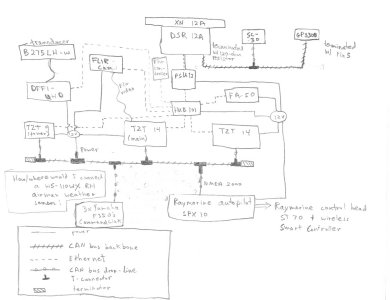Update and 2 questions:
Things went pretty well over the weekend ... Considering. I didn't mention the boat's location, but it is Nantucket. Which got a hard, but luckily glancing, blow from hurricane Arthur on Friday. So my 3 days of work time was effectively condensed to 1.5, because I had to spend time preparing the boat (on a mooring) before, and cleaning up after. Luckily the only damage was water in the cabin, but pulling out sopping wet mattresses, as it turns out, is a huge job! Also spent some time organizing the boat's fishing gear, and cleaning, since these were the first days on the water.
Anyway, got all the old Raymarine stuff that I won't be using out, except for the radar. And got in the two big, main MDFs. (Also installed a Garmin side scan unit / back-up chart plotter, that is totally independent from this system). Got bogged down in fabricating a panel to overlay the existing cutouts, and running some wires to the tower, so didn't do much more than that.
But the path forward is pretty clear, and there are no more difficult installs of hardware to do. Just some running of wires, which will probably be time consuming. Hopefully will be able to finish this weekend!
Anyway, for the questions: for the DRS12/SC-30 "mini-network", I need another resistor (Furuno part # 000-167-746), but can't find a place online to buy. Any ideas?
And for the FLIR unit (and potentially for my underwater camera) I was thinking of buying a video-to-IP converter so that I can see the FLIR through the ethernet (at both the upper and lower stations). Any advice of a good one to buy?




